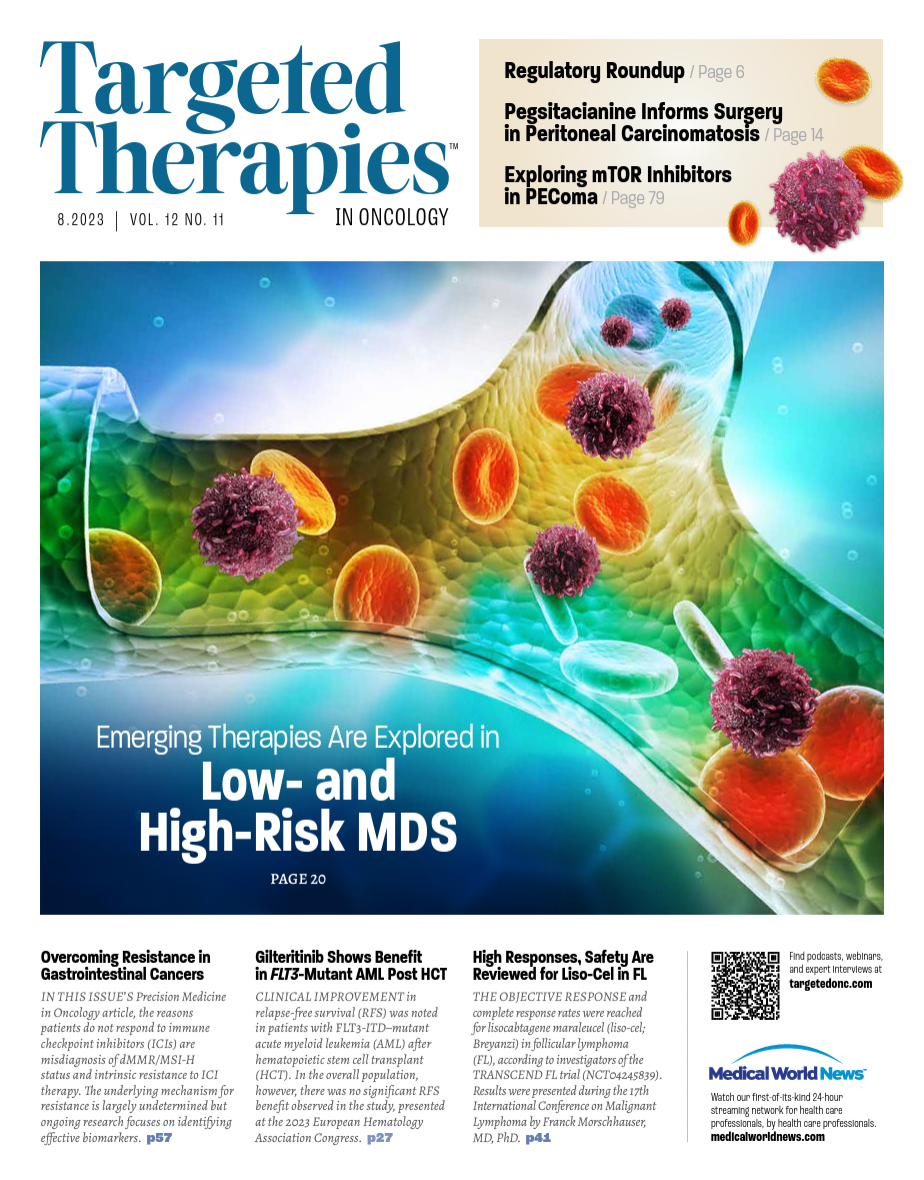Ziftomenib Induces Clinical Activity in NPM1-Mutated R/R AML
Ziftomenib showed safety and efficacy in heavily pretreated patients with comutations and NPM1-mutated, relapsed/refractory acute myeloid leukemia.
Amir Fathi, MD
Associate Professor of Medicine
Harvard Medical School
Program Director, Center for Leukemia
Massachusetts General Hospital
Boston, MA

Treatment with ziftomenib, a menin-MLL (KMT2A) inhibitor, appeared to be safe and effective in heavily pretreated patients with comutations and NPM1-mutated, relapsed/refractory (R/R) acute myeloid leukemia (AML), according to phase 1 data from the KO-MEN-001 trial (NCT04067336) presented at the European Hematology Association 2023 Congress, in Frankfurt, Germany.
Treatment-emergent adverse events (TEAEs) of any grade occurred in 19 patients (95%), including diarrhea (n = 9; 45%), hypokalemia (n = 8; 40%), and nausea (n = 6; 30%). Seventeen patients (85%) experienced a TEAE of grade 3 or above, including anemia (25%) and thrombocytopenia (20%). In addition, 12 patients (60%) reported treatment- related AEs (TRAEs) of any grade, including nausea (20%) and differentiation syndrome (20%). Six patients had TRAEs of grade 3 or above (30%).
“We know that differentiation syndrome is an adverse event of particular interest with this class of agents. Among these 20 patients, there was only 1 report of a grade 3 differentiation syndrome. And that particular case was managed successfully with appropriate mitigation, including with steroids,” Amir Fathi, MD, explained, adding that there were also no reports of drug-induced corrected QT prolongation. Fathi is associate professor of medicine at Harvard Medical School and program director of the Center for Leukemia at Massachusetts General Hospital, both in Boston.
“This is similar to previous reports, and we did not find any new safety signals to report here today,” he said.
Furthermore, the complete remission (CR) rate was 35%, with a composite CR (cCR) rate of 40% and an overall response rate of 45%. Patients with comutations of FLT3 and IDH demonstrated CR rates of 33% and 50%, respectively.
“[A] patient with complete remission and incomplete hematologic recovery [underwent] transplant and is currently in remission following stem cell transplant,” Fathi said. “The patients with [morphologic leukemia-free state], unfortunately, prior to achieving count recovery, died from complications of COVID-19 infection.”
The median time to first response to ziftomenib was 51 days (range, 26-225). Median DOR for those with cCR was 8.2 months (95% CI, 1.0-not evaluable).
Two patients underwent stem cell transplant, including 1 patient who remains in CR on ziftomenib for post–stem cell transplant maintenance and 1 patient who remains in CR without treatment maintenance. Four of 6 patients (67%) who achieved cCR had mismatch repair– deficient (MRD)-negative disease. “In theory, we feel that this agent does retain activity against several of these resistance mutations,” Fathi said.
Finally, following reports of MEN1 resistance mutations with another menin inhibitor, an analysis of the trial identified 1 patient (3.4%) with the resistance mutation that was acquired while on ziftomenib treatment. Furthermore, the MEN1 resistance mutation was not detected in 13 other patients who received 2 or more cycles of ziftomenib with best responses of stable and progressive disease “suggesting that progression or lack of response in these [patients] is not due to MEN1 mutations,” according to Fathi.
Study Background
Although the prognosis for those with AML can be favorable, Fathi noted that “patients who are older, patients with certain concurrent mutations, and certainly those with relapsed or refractory disease have a much more suboptimal outcome. As of yet, there is no FDA-approved NPM1 mutation– specific targeted therapy that exists today for AML.”
Therefore, in the global, open-label phase 1/2 KO-MEN-001 trial, Fathi and colleagues evaluated ziftomenib as treatment for adult patients with R/R AML. Fathi discussed the phase 1 dose escalation and randomized dose expansion portion of the trial in patients with KMT2A rearrangements or NPM1 mutations.
In the phase 1b expansion trial, 20 patients received a single daily dose of 600 mg ziftomenib orally in 28-day cycles. The main objectives were safety and tolerability, pharmacokinetics, and clinical activity.
The median number of lines of prior therapy was 3 (range, 1-10), with most receiving prior venetoclax (Venclexta; 65%) and previous stem cell transplant (20%). Thirty percent of patients also had an FLT3 mutation, 40% had an IDH1/2 mutation, and 20% had a combination of both mutations.
Seven patients were still in follow-up (35%). Reasons for treatment discontinuation were AEs not related to the study drug (25%), disease progression (45%), and other reasons (25%). Thirteen patients discontinued the study because of death (65%).
Next Steps
The pivotal KO-MEN-001 trial is currently recruiting patients with NPM1-mutated R/R AML. In addition, the phase 1 KO-MEN-007 trial (NCT05735184) is open for enrollment, with the aim to evaluate ziftomenib in combination with existing intensive and nonintensive chemotherapy standards of care in newly diagnosed and R/R NPM1-mutated or KMT2A-rearranged AML. “There is also an ongoing phase 2 registration-enabling study with a primary end point of CR and CRh [complete remission with partial hematologic recovery],” Fathi said.
REFERENCE:
Fathi A, Wang E, Issa G, et al. Activity, tolerability, and resistance profile of the menin inhibitor ziftomenib in adults with relapsed/refractory NPM1-mutated AML. Abstract presented at: EHA2023 Hybrid Congress; June 8-11, 2023; Virtual and Frankfurt, Germany. Abstract LB2713.

Survivorship Care Promotes Evidence-Based Approaches for Quality of Life and Beyond
March 21st 2025Frank J. Penedo, PhD, explains the challenges of survivorship care for patients with cancer and how he implements programs to support patients’ emotional, physical, and practical needs.
Read More